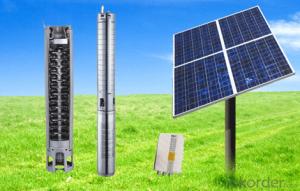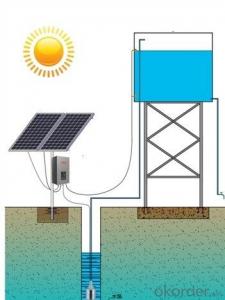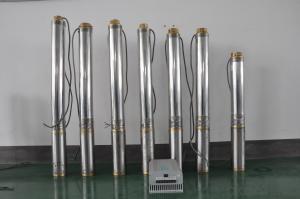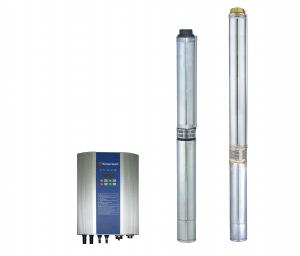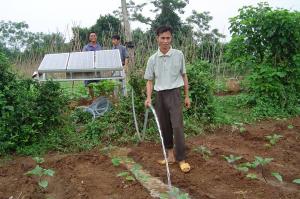Solar Pump Price Homemade Solar Water Heater
- Loading Port:
- Shanghai
- Payment Terms:
- TT OR LC
- Min Order Qty:
- 1 set
- Supply Capability:
- 1000 set/month
OKorder Service Pledge
OKorder Financial Service
You Might Also Like
Solar Pump Price Homemade Solar Water Heater
DC solar water pumping system consists of the motor, pump, controller, solar array and some other accessories, such as water level sensor, float switch, etc. Considered that storing water is more efficient than storing electricity, the system is designed to directly drive the pump without battery which can reduce the construction and operating cost and routine maintenance effectively.The PV array consists of multiple solar panels connected in series/parallel, which can supply the whole system as power source by converting the absorbed solar radiation energy to the electrical energy. The pump driven by a brushless DC permanent magnet motor draws water from deep-well or river. The pumped water is then fed into reservoir or water tank, or connected to the irrigation system or fountain system directly.
Advanced Technology
Applications Innovation
The efficiency of DC brushless permanent magnet motor has been increased up to 25% in comparison with traditional asynchronous motor.
Technology Innovation
Stator and rotor are sealed by environment friendly casting resin.Motor insulation resistance can be hold higher than 300MΩfor more than 10 years, which consumedly increased the security and reliability of the submersible motor.
Structure Innovation
Casting resign technology processed stator and rotor as well as the water lubricated bearing make the submersible pump environment friendly.
Feature
High Efficiency & High Reliability
DC Brushless Permanent Magnet Motor
Minimum Maintenance, long Service Life
Environment Friendly Materials, Lubricated Without Oil
Application
Village or Family Water Supply
Animal Drinking Water & Livestock Watering
Garden/Courtyard Irrigation
Swimming Pool
Water Supply for Bivouac or Camping Car
Water Supply for Remote Area
Automatic Control
Operate Automatically, No Need Watching
Maximum Power Point Tracking (MPPT)
Dry-run Protection
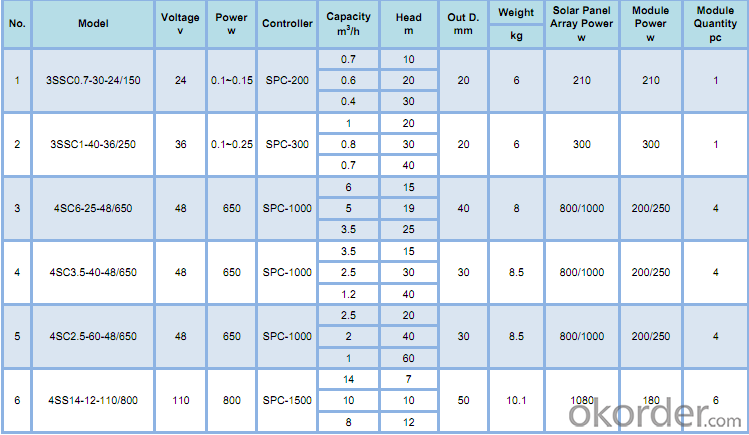
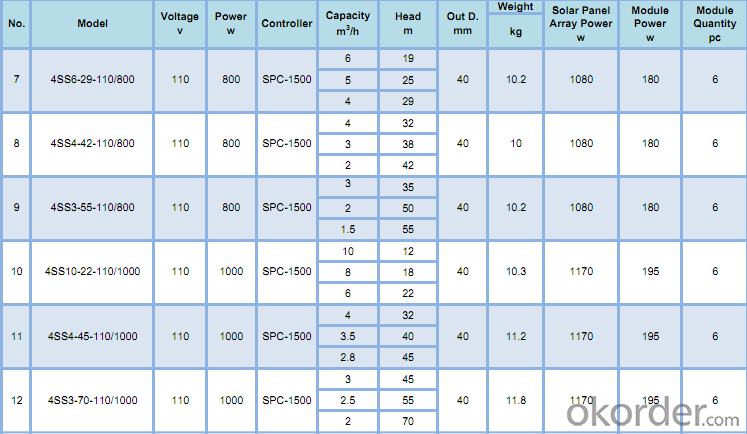
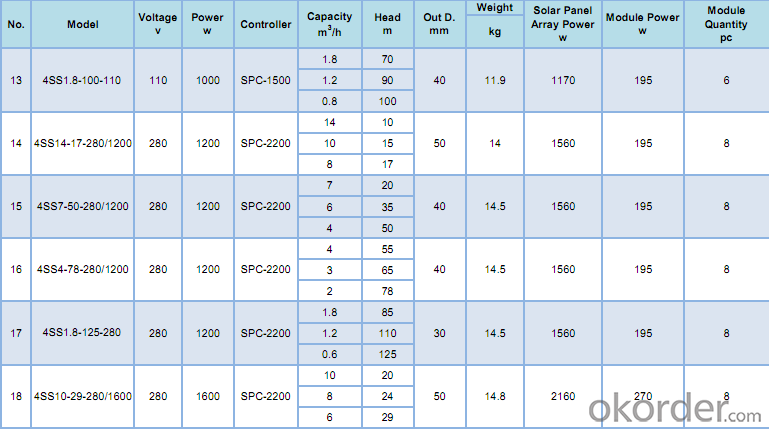
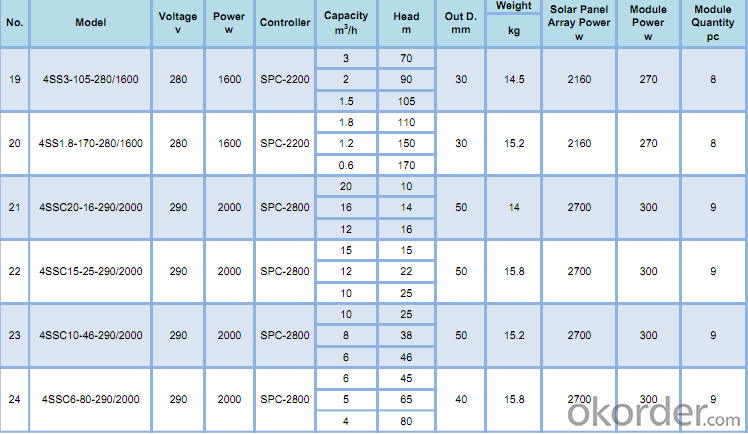

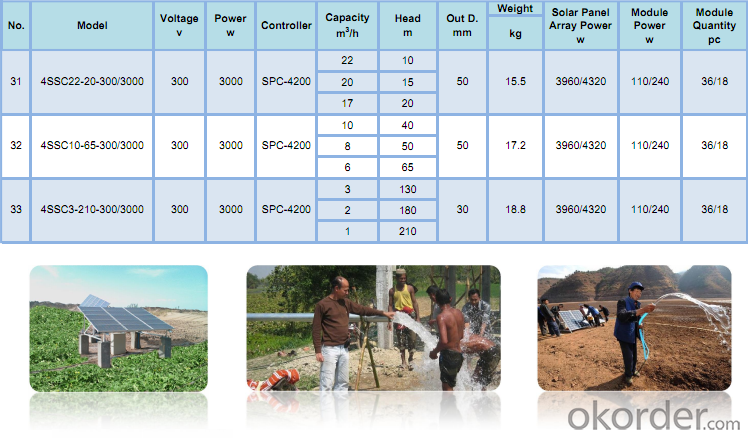
- Q:Can solar pumps be used for water supply in wildlife reserves or conservation areas?
- Yes, solar pumps can be used for water supply in wildlife reserves or conservation areas. Solar pumps provide a sustainable and environmentally friendly solution for pumping water, allowing for reliable water supply without the need for grid electricity or fuel. This is particularly beneficial in remote or off-grid areas where wildlife reserves and conservation areas are often located. Moreover, solar pumps can help maintain natural water sources and support the preservation of wildlife habitats.
- Q:Can a solar pump be used for water supply in a disaster-stricken area?
- Yes, a solar pump can be used for water supply in a disaster-stricken area. Solar pumps are an efficient and sustainable solution that can provide a reliable source of water even in remote or off-grid locations. They rely on solar energy to power the pump, eliminating the need for electricity or fuel, making them ideal for disaster situations where infrastructure may be damaged or inaccessible. Additionally, solar pumps are easy to install and maintain, making them a practical choice for providing immediate water supply in emergency situations.
- Q:How does the cost of operating a solar pump compare to a traditional electric pump?
- The cost of operating a solar pump is generally lower compared to a traditional electric pump. Solar pumps utilize energy from the sun, eliminating the need for electricity from the grid, thus reducing operating costs. Solar pumps also have lower maintenance needs since they have fewer moving parts compared to electric pumps. Additionally, solar pumps are not affected by fluctuating electricity prices, making them a more cost-effective and sustainable option in the long run.
- Q:Are there any limitations on the distance water can be pumped with a solar pump?
- Yes, there are limitations on the distance water can be pumped with a solar pump. The maximum pumping distance depends on various factors such as the power of the solar pump, efficiency of the pumping mechanism, elevation changes, friction losses in the pipe, and the desired flow rate. Generally, solar pumps are most effective for shorter pumping distances, typically up to a few hundred feet. Beyond that, the pumping efficiency decreases, and additional equipment may be required to overcome the limitations.
- Q:Can a solar pump be used for water supply in off-grid military bases?
- Indeed, water supply in off-grid military bases can be facilitated through the use of solar pumps. These pumps present themselves as a sustainable and cost-effective alternative for remote locations where traditional electricity is not easily accessible. By harnessing solar energy through photovoltaic panels, these pumps are able to convert sunlight into electricity, which is then utilized to operate the pump that draws water from a well or other water source, subsequently supplying it to the base. Solar pumps boast numerous advantages for off-grid military bases. To begin with, they operate independently from the power grid, eliminating the necessity for expensive and regularly maintained fuel or diesel generators. Consequently, solar pumps are more reliable and self-sustaining, diminishing the logistical challenges associated with fuel supply in remote areas. Additionally, in comparison to conventional pumps, solar pumps have a reduced environmental impact. They do not release greenhouse gas emissions or generate noise pollution, making them an ideal choice for military bases that prioritize sustainability and minimizing their ecological footprint. Furthermore, solar pumps can be effortlessly installed and operated in various terrains. They necessitate minimal maintenance and possess a prolonged lifespan, guaranteeing a consistent and dependable water supply for military personnel stationed in off-grid regions. In conclusion, solar pumps are a feasible option for fulfilling water supply requirements in off-grid military bases. They offer a sustainable and cost-effective solution, operate independently from the power grid, have a diminished environmental impact, and are simple to install and maintain.
- Q:Can a solar pump be used in areas with limited access to water consumption?
- Yes, a solar pump can be used in areas with limited access to water consumption. Solar pumps are designed to utilize solar energy to pump water from various sources such as wells, rivers, or lakes. They are an excellent solution for areas with limited access to water as they do not require grid electricity or fuel, making them cost-effective and environmentally friendly. Additionally, solar pumps can be easily installed and maintained, providing a reliable water supply for agricultural, domestic, or irrigation purposes in areas with limited water consumption.
- Q:Can a solar pump be used for water supply in off-grid dairy farms?
- Indeed, water supply in off-grid dairy farms can be facilitated through the utilization of solar pumps. When it comes to off-grid applications, solar pumps prove to be an exceptional choice due to their reliance on solar energy, thereby eliminating the necessity for grid electricity. These pumps harness the power of photovoltaic (PV) panels to convert sunlight into electricity, which in turn energizes the pump to transport water from its source to the desired destination. For dairy farms situated in secluded regions without access to the grid, solar pumps offer a dependable and eco-friendly solution for water supply. They can effectively extract water from wells, boreholes, or other water sources and efficiently distribute it across the farm to fulfill the requirements of various areas such as livestock watering troughs, cleaning systems, or irrigation systems. Solar pumps come with numerous advantages for off-grid dairy farms. Primarily, they prove to be cost-effective in the long run as they eliminate the need for electricity bills or fuel expenses. Moreover, their maintenance needs are minimal, thereby reducing operational costs. Additionally, solar pumps are environmentally friendly, as they generate clean energy and do not contribute to the emission of greenhouse gases. It should be noted that the appropriate size and capacity of the solar pump must be chosen based on the specific water demands of the dairy farm. Factors such as the number of livestock, daily water consumption, and distance to the water source should be taken into account when selecting a suitable solar pump system. In conclusion, solar pumps represent a feasible and efficient choice for water supply in off-grid dairy farms, offering a reliable and sustainable solution to meet the farm's water requirements while simultaneously reducing costs and minimizing environmental impact.
- Q:How much sunlight is required for a solar pump to operate effectively?
- Several factors, such as the type and capacity of the pump, the location, and the specific requirements of the application, determine the amount of sunlight necessary for a solar pump to function effectively. Generally, solar pumps are designed to operate optimally in areas with abundant sunlight. They rely on direct sunlight to produce electricity through PV panels, which powers the pump. While most solar pumps can operate with varying levels of sunlight, their efficiency and performance may be significantly reduced in low light conditions or on cloudy days. The exact amount of sunlight required can vary, but as a general guideline, a solar pump typically needs a minimum of 4 to 5 hours of direct sunlight per day to function effectively. It is worth noting that some solar pumps are equipped with battery storage systems, enabling them to operate even when sunlight is unavailable. These pumps can store excess energy generated during the day and utilize it later when sunlight is limited. This feature ensures continuous operation during low light conditions or at night. To determine the specific sunlight requirements for a solar pump, it is advisable to consult the manufacturer's specifications or seek professional advice from a solar pump installer or supplier. They can provide more precise information based on the specific pump model and application requirements.
- Q:What is the expected lifespan of the solar panels in a solar pump system?
- The expected lifespan of solar panels in a solar pump system can vary depending on several factors such as the quality of the panels, maintenance practices, and environmental conditions. However, on average, good quality solar panels can last anywhere from 25 to 30 years or even longer with proper care and regular maintenance.
- Q:Can solar pumps be used for water supply in wildlife conservation or rehabilitation projects?
- Yes, solar pumps can be used effectively for water supply in wildlife conservation or rehabilitation projects. Solar pumps are an eco-friendly and sustainable solution that can provide a reliable water source for wildlife in remote locations. They eliminate the need for electricity or fuel and can operate in areas with limited infrastructure. Solar pumps also reduce the disturbance caused by human intervention, ensuring a more natural and undisturbed environment for wildlife.
1. Manufacturer Overview |
|
|---|---|
| Location | |
| Year Established | |
| Annual Output Value | |
| Main Markets | |
| Company Certifications | |
2. Manufacturer Certificates |
|
|---|---|
| a) Certification Name | |
| Range | |
| Reference | |
| Validity Period | |
3. Manufacturer Capability |
|
|---|---|
| a)Trade Capacity | |
| Nearest Port | |
| Export Percentage | |
| No.of Employees in Trade Department | |
| Language Spoken: | |
| b)Factory Information | |
| Factory Size: | |
| No. of Production Lines | |
| Contract Manufacturing | |
| Product Price Range | |
Send your message to us
Solar Pump Price Homemade Solar Water Heater
- Loading Port:
- Shanghai
- Payment Terms:
- TT OR LC
- Min Order Qty:
- 1 set
- Supply Capability:
- 1000 set/month
OKorder Service Pledge
OKorder Financial Service
Similar products
New products
Hot products
Hot Searches
Related keywords
